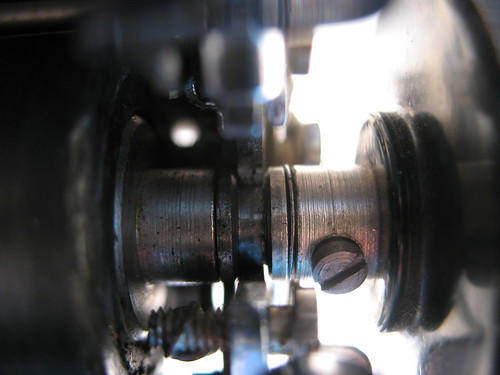...it didn't budge.
Uh oh.
I've been puzzling about this for a week or so, swapping in platens from other era machines to try and narrow the issue down. I'd mistakenly thought it wasn't the platen at all, but the little silver cup that it sockets into on the left. This one:

It felt like the platen wasn't seated properly, and was rubbing up against the frame somewhere: maybe it didn't seat far enough into this socket? Maybe that's why the machine was given up for thrift after all? And of course there's always the possibility that I've blundered horribly and bent or broken some essential, tiny part in my haste.
As the platen worked fine in the later-model machine (and vice versa) I'd gotten to the point where I was just going to switch the right-hand knobs and be done with it. But you see, I'd know. I'd know that the machines had cross-donated parts, and I'd know that it was a wrongness. That highly-developed OCD corner of my brain would not let me rest. So what's going on?
In short, a matter of fine, fine tolerances.

That's the right-hand knob on this machine, in extreme close-up. That little pinched-in area of the shaft fits down inside the frame into a little U-shaped slot. It has to fit just right, and the platen shaft actually rotates inside of the pinched-in collar.

The spring-tensioned lever on the side of the carriage holds the platen down into that U-shaped opening. It must sit there -- there's no other choice.
What you do have a choice on, though, is how you fit that little collar back onto the platen. When I was first exploring this machine, I removed the right-hand knob, and then found the sliding lever animated above. The knob came off happily, and when I lifted out the platen, the collar and a small washer fell off and bounced on my desk. I put them back on and reattached the knob without a second thought.
A shame, too, since a second thought would have got me to change the order of the parts. I had:
washer - collar - knob
And I evidently should have assembled them:
collar - washer - knob
as shown in the picture above. It's a small, but crucial difference. With the parts in the right order, the resistance goes from superhuman effort to butter smooth. I had also managed to move the little wheel that travels over the ratchet on the left-hand side, which I've managed to get realigned now thanks to a dollar-store dental pick and some focused carriage acupressure.
Except for a pair of shell screws that doggedly are resisting going back in (tiny screws, ham hands) the Silent is almost ready for an inaugural typecast.

2 comments:
Very impressed with this and the previous post. Good luck with your efforts!
Excellent attention to detail! Looking forward to inaugural typecast, and maybe you adding this machine to the Typewriter Database? :D
Post a Comment